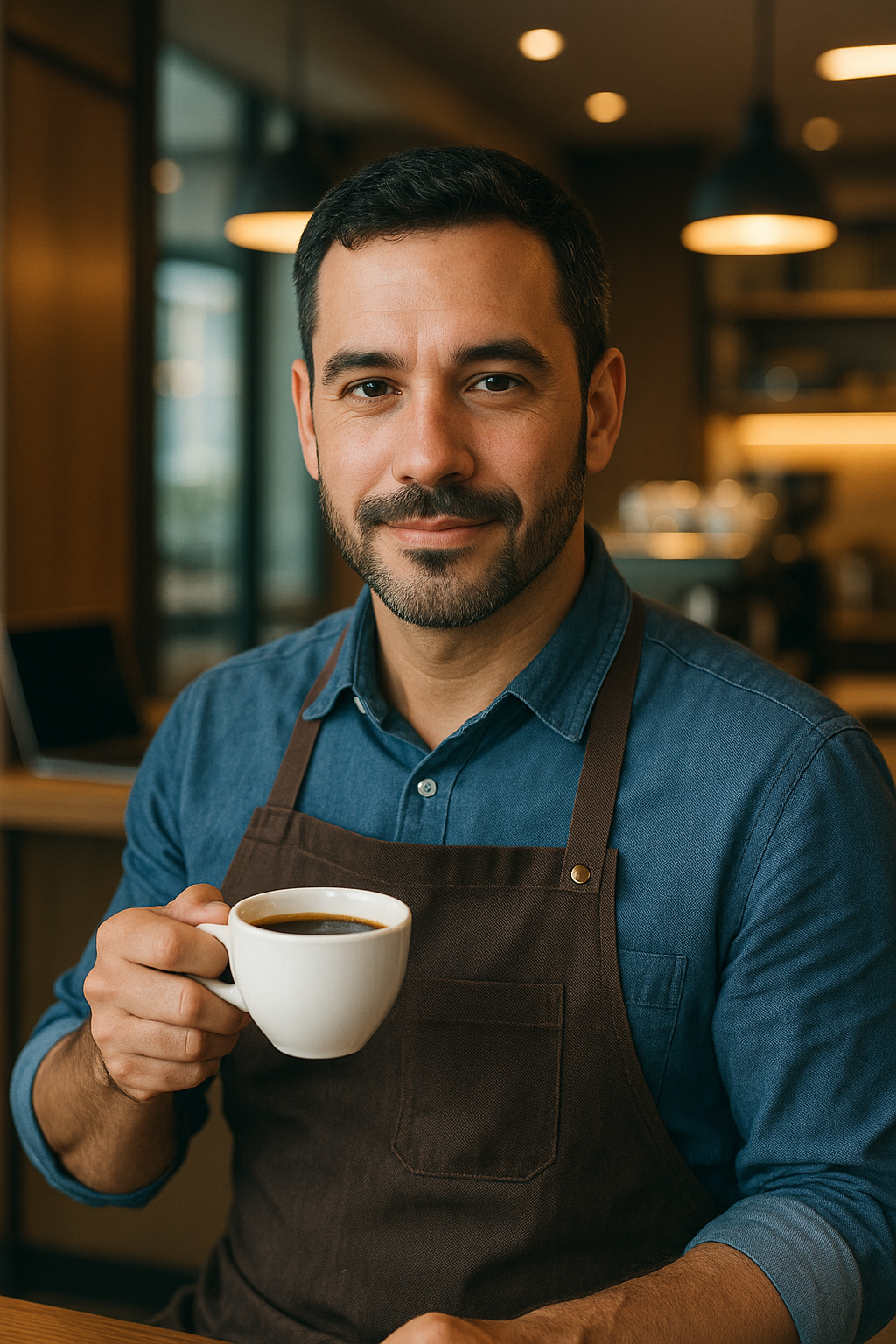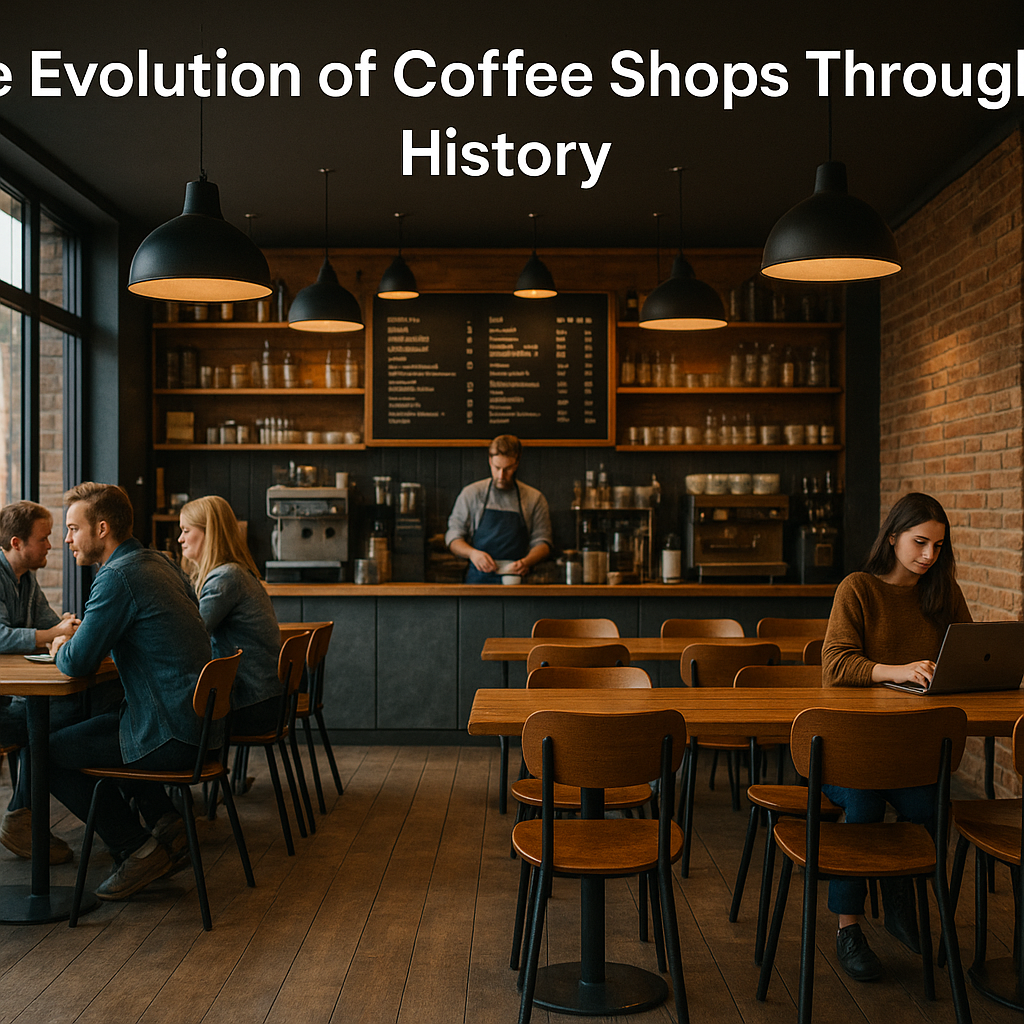Coffee shops today are more than just places to grab a caffeine fix—they’re workspaces, social hubs, creative retreats, and cultural landmarks.
But this wasn’t always the case. Coffee shops have undergone a remarkable transformation over the centuries, evolving alongside the societies they serve.
In this article, we’ll journey through time to see how coffee shops developed—from sacred social spaces in the Middle East to bohemian salons in Europe, from modern digital cafés to the rise of specialty coffee bars—highlighting their changing role in society and what they’ve always had in common: a place for people to come together and think.
The Birthplace: Middle Eastern Coffeehouses
The first coffeehouses—qahveh khaneh—emerged in the Islamic world during the 15th and 16th centuries, particularly in Mecca, Cairo, and Istanbul. These spaces weren’t just places to drink coffee; they were intellectual and cultural centers.
In an era before newspapers or smartphones, coffeehouses served as sites of public discourse. People would gather to:
- Listen to music and poetry
- Watch performers
- Engage in political and religious discussions
- Play games like chess and backgammon
These cafés were inclusive and vibrant, attracting scholars, merchants, and artists alike. Because of their role in fostering conversation and critical thought, they were sometimes viewed suspiciously by rulers and religious authorities—some even tried to ban coffeehouses altogether.
European Enlightenment and the Rise of the “Penny University”
By the 17th century, coffee made its way into Europe, bringing with it the coffeehouse model. London, Paris, and Vienna were among the first cities to embrace this new form of social gathering.
In England, particularly London, coffeehouses became known as “penny universities” because for a penny (the cost of a cup of coffee), you could access a wealth of information and intellectual conversation.
Coffeehouses in London were often themed or profession-specific:
- Politicians met at Will’s Coffee House
- Scientists gathered at Greene’s
- Writers and publishers frequented Button’s
These spaces became epicenters of innovation. Financial institutions like Lloyd’s of London actually began in coffeehouses, as did early versions of literary journals and scientific societies.
Viennese Coffeehouses: Tradition and Elegance
Vienna’s coffeehouses stand apart for their emphasis on elegance, service, and culture. Beginning in the late 17th century, these cafés offered patrons an inviting environment to read newspapers, write letters, and engage in leisurely conversation.
Unlike their British counterparts, which often had a faster pace, Viennese cafés were places to linger for hours. A typical order came with a glass of water and access to newspapers. Famous thinkers and artists such as Freud, Trotsky, and Klimt were regulars at Vienna’s iconic cafés.
In 2011, UNESCO recognized the Viennese Coffee House Culture as an Intangible Cultural Heritage, preserving its status as a symbol of hospitality and intellectual life.
19th Century: The Bohemian Café Culture
As Europe industrialized, the coffeehouse became a symbol of counterculture and creative expression. In Paris, cafés in Montmartre and the Latin Quarter became hangouts for artists, poets, and political radicals.
Figures like Ernest Hemingway, James Joyce, and Gertrude Stein worked in Parisian cafés during the early 20th century. The bohemian café was romanticized as a place where ideas, romance, and rebellion flourished side by side.
This tradition extended to other cities:
- Berlin: A hub for avant-garde thinkers and modernist artists
- New York: Greenwich Village cafés became centers for Beat poets and jazz musicians
- San Francisco: The Beat Generation found a home in cafés like Caffe Trieste
These spaces often mixed coffee with art, performance, and protest, shaping modern culture.
The Rise of the American Coffee Shop
In the United States, the coffee shop took on a different identity in the 20th century. It became part of the diner culture—a place where working-class people could get a hot drink, a sandwich, and maybe a slice of pie.
Later, in the 1960s and 70s, the coffeehouse again took on political importance, especially in college towns and urban centers. Coffeehouses became venues for:
- Protest meetings
- Folk music performances
- Feminist and civil rights organizing
Coffee wasn’t just a drink—it was a backdrop for activism.
The Starbucks Era: Coffee Goes Global
The 1990s saw the rise of corporate coffee chains, led by Starbucks. Suddenly, the coffee shop became a global franchise model, blending familiarity with upscale aesthetics.
Starbucks rebranded the coffee shop as a “third place”—somewhere between home and work. The model encouraged people to:
- Stay longer
- Work remotely
- Socialize in a curated environment
With free Wi-Fi, comfortable seating, and consistent branding, these cafés spread globally and helped normalize café culture in countries where it hadn’t been mainstream.
While some critics accused chains like Starbucks of homogenizing local coffee traditions, others credit them with reviving interest in social coffee drinking.
The Third Wave Movement: Back to Craft
In the 2000s and 2010s, a new movement emerged in response to the commodification of coffee: Third Wave Coffee. This movement emphasized:
- Single-origin beans
- Sustainable sourcing
- Artisan roasting and brewing
- Barista skill and education
Third wave cafés are often minimalist, focused on the coffee itself rather than comfortable furniture or large food menus. These shops cater to coffee connoisseurs and value transparency and craftsmanship.
Notable third wave brands include:
- Blue Bottle Coffee (USA)
- Tim Wendelboe (Norway)
- Stumptown Coffee Roasters (USA)
- Toby’s Estate (Australia)
These spaces often double as community hubs and educational platforms, offering cupping sessions, brewing workshops, and discussions on ethical sourcing.
The Digital Café: Coffee and Remote Work
With the advent of remote work and digital nomadism, coffee shops have become informal coworking spaces. Laptops are now as common as coffee mugs.
Modern cafés are designed with freelancers in mind, offering:
- Power outlets at every seat
- Fast, reliable Wi-Fi
- Open seating or communal tables
- Quiet background music
Cafés have evolved into productivity zones, allowing people to write, design, code, and collaborate outside traditional offices. Some cities have even developed “café ecosystems,” where remote workers rotate between multiple cafés throughout the week.
The Future: Specialty, Sustainability, and Community
The next evolution of coffee shops will likely focus on:
- Sustainability: Zero-waste initiatives, compostable cups, reusable systems
- Community integration: Cafés that support local artists, farmers, and non-profits
- Tech innovation: Coffee brewed with precision robots, AI-recommendation menus
- Inclusive design: Accessible spaces for all ages and abilities
We may also see a blending of formats—cafés doubling as bookstores, record shops, bike repair stations, or wellness studios.
What Never Changes: The Human Connection
Despite centuries of change, the core function of the coffee shop remains the same: it’s a place to gather, to think, to connect. Whether in a medieval qahveh khaneh or a sleek Tokyo café with Bluetooth speakers, the purpose is unchanged.
Coffee shops are where ideas are born, friendships deepen, and solitude finds comfort. Their evolution reflects our changing world—but their spirit remains timeless.

Marcelo Oliveira is a coffee enthusiast and content creator specializing in barista skills, brewing methods, equipment reviews, coffee-related health insights, and fascinating curiosities from the coffee world. With a deep passion for every step of the brewing process, he turns technical knowledge into accessible and engaging content for both beginners and seasoned coffee lovers. Marcelo’s goal is to help readers appreciate the full experience of coffee—from bean to cup.
